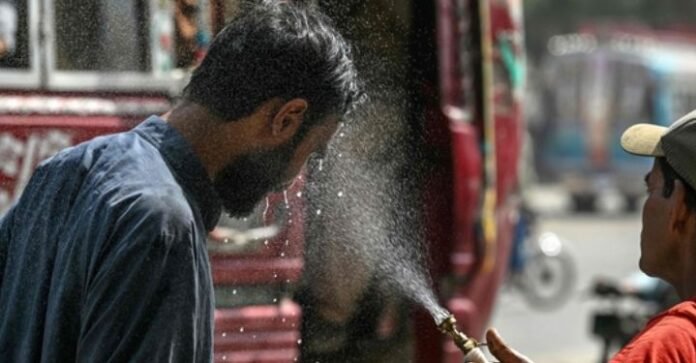Delhi, the capital of India, is bracing for an intense heat wave as the mercury is expected to soar to a maximum of 41°C today. With soaring temperatures and worsening air quality, residents are being advised to take precautions to stay safe and avoid the harsh impact of the heat and pollution. The combination of a scorching sun and a ‘poor’ Air Quality Index (AQI) is expected to significantly affect outdoor activities, making it crucial for citizens to be mindful of their health and well-being.
Weather Conditions
Delhi’s weather is typically characterized by hot summers, with temperatures regularly exceeding 40°C in May and June. However, the high of 41°C today marks a particularly intense day in what has already been a warmer-than-usual April. The capital is set to experience clear skies with minimal chances of rain, which can offer a brief respite from the relentless heat.
According to the India Meteorological Department (IMD), the maximum temperature today is expected to hover around 41°C, and there will be little relief until late evening. The IMD forecasts that the minimum temperature will dip to a more tolerable 25°C. Humidity will likely be high, contributing to an increased feeling of discomfort despite the dry heat.
A combination of high temperatures and dry conditions is expected to worsen the effects of the already poor air quality, with particulate matter (PM2.5) levels increasing, further compromising residents’ health.
Air Quality Crisis
Alongside the oppressive heat, Delhi’s air quality is forecast to be in the ‘poor’ category today. According to the latest AQI data, the PM2.5 levels are expected to be dangerously high, a reminder of the ongoing pollution crisis that continues to plague the city. The poor air quality is caused by a mixture of local pollution from vehicular emissions, industrial activity, dust from construction sites, and weather conditions that prevent the dispersal of pollutants.
An AQI in the ‘poor’ range is defined as having levels between 201 and 300, which can be harmful to people with respiratory conditions such as asthma or bronchitis. The government has urged citizens to stay indoors as much as possible, particularly in the afternoon when the sun is at its hottest, and the pollution levels are at their peak.
Experts also warn that exposure to polluted air over extended periods can lead to significant health issues, including lung damage, cardiovascular diseases, and exacerbated symptoms for those already suffering from respiratory conditions. The combination of intense heat and poor air quality poses an additional challenge to the city’s vulnerable populations, including children, the elderly, and those with pre-existing health conditions.
Health Precautions
Given the heat and pollution, it is crucial for Delhi residents to take steps to protect their health. Medical experts recommend staying indoors during peak heat hours (12 PM to 4 PM) when both the temperature and pollution levels are at their highest. If outdoor exposure is necessary, people should wear face masks designed to filter out particulate matter, such as N95 masks, which are effective in reducing the intake of harmful particles.
Hydration is another key measure to prevent heat-related illnesses such as heatstroke and dehydration. It is essential to drink plenty of fluids throughout the day, particularly water, to maintain body temperature and prevent overheating. People are also advised to wear light, breathable clothing to minimize discomfort and prevent sunburn.
Those with respiratory issues should avoid outdoor activities during the hottest part of the day and limit exposure to polluted air. For those who must commute, it’s recommended to use air-conditioned transportation and avoid walking or cycling in high-traffic areas where air pollution tends to be higher.
Urban Challenges and the Future Outlook
The persistent combination of high temperatures and poor air quality has brought to light the significant challenges facing Delhi’s urban environment. The city’s rapid urbanization, coupled with its heavy reliance on fossil fuels for transportation and energy, has resulted in a climate that is increasingly difficult to live in. Studies have shown that air pollution and extreme weather events like heatwaves are expected to increase in frequency and intensity as climate change accelerates, making it more difficult for cities like Delhi to adapt.
The government has undertaken various measures to improve air quality, such as expanding the public transport system, promoting the use of electric vehicles, and increasing green spaces within the city. However, these efforts have not yet yielded significant improvements, and the citizens of Delhi continue to suffer from poor air quality on a daily basis.
The rising temperatures and declining air quality are not only a matter of comfort but also a critical public health issue. According to a report from the World Health Organization (WHO), Delhi is one of the most polluted cities in the world, with air pollution contributing to thousands of premature deaths each year. The health costs associated with pollution are astronomical, placing a strain on both the healthcare system and the economy.
What Can Be Done?
The responsibility of improving air quality and managing extreme heat lies not only with the government but also with individuals, businesses, and industries. On a personal level, citizens can make a difference by using public transport, reducing waste, and conserving energy. On a larger scale, policymakers must invest in sustainable infrastructure, renewable energy, and stricter regulations on pollution levels to reduce the city’s environmental footprint.
In the long run, it will take a concerted effort from all sectors of society to address the root causes of pollution and mitigate the effects of extreme weather events. For now, the immediate focus must be on coping with the heat and pollution, ensuring that residents take necessary precautions to stay safe during this challenging period.

